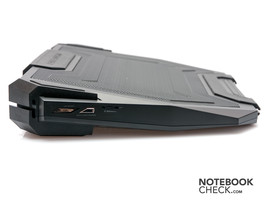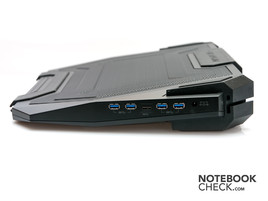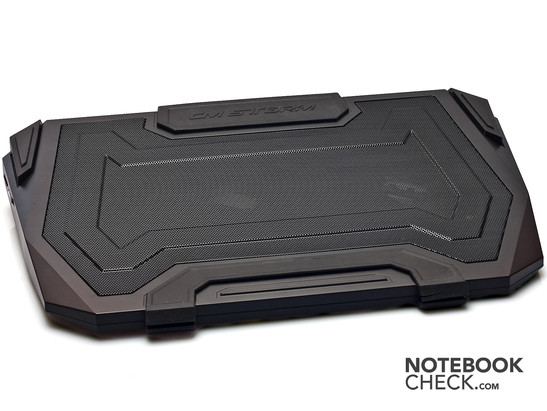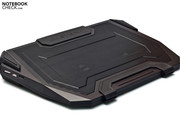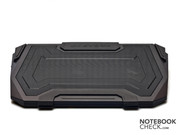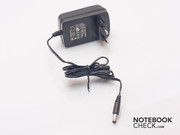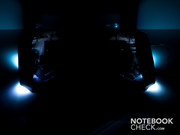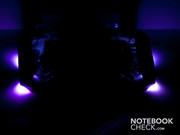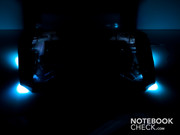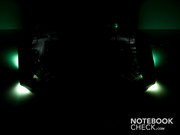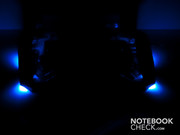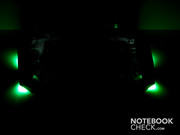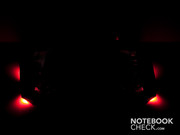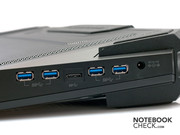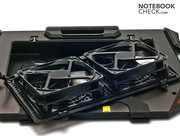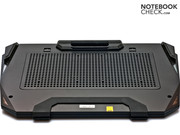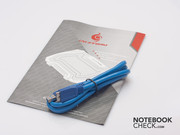Review Cooler Master SF-19 Strike Force
Everyone who occasionally puts their notebook under a bit of load (keyword: gaming), and maybe even has driven it to its limits, knows how annoying and, in particular how loud, the incorporated cooling system can get. Above all, owners of a gaming or high-end notebook can tell you a thing or two about how fast a notebook increases its noise under load. Although this is only an acoustic aggravation in the cold winter months, it can get hazardous for the hardware in the summertime. When outdoor temperatures rise, the temperatures in the notebook also increase and not every cooling system can manage the intensifying temperatures.
This can quite simply be prevented by a few additional case fans in desktop computers. However, it's not as easy to accomplish in a laptop. Therefore, a few accessory manufacturers have taken on this problem and attempt to deal with this adverse issue. One of these manufacturers is the company, Cooler Master, which has specialized on gamers' requirements with the CM Storm range. The SF-19 notebook cooler is made for 19 inch laptops and is not only to cool them but also extend the devices by USB connections and light effects. We will examine if the SF-19 is really a reasonable acquirement or if it's just an unreasonable gadget in the course of the following review.
Case & Design
The SF-19's design fits very well to current gaming laptops. We can especially imagine the Asus G range on the notebook cooler, as it has a similar design language. The cooler is made completely in black and shows an aggressive, but clear design. The cooler's wedge shape additionally provides a more ergonomic work/gaming position since the display is elevated a bit towards eye level. Rubber pads have been placed at the edges to keep the notebook from sliding from the cooler and keep it in position. Moreover, these pads also serve as cable ducts through which cables from peripheral devices or the adapter cable can be led. The cooler's main surface is made entirely of a perforated steel plate so that air can flow to the notebook. There are two 140 millimeter sized fans underneath this plate that scoop air to the notebook and thus provide fresh air. On the bottom, there is a practical handle for carrying the notebook cooler around easily.
But the SF-19 not only looks good – its manufacturing is also right. Although the frame is made of plastic, the entire construction makes a very solid impression. Thus, even really heavy laptops can be placed safely on the cooler. The covers on the rear also fit perfectly in the openings and don't give reason for complaint.
Unfortunately, we received our model with a minor production flaw. The rubber cable duct on the front right had a small tear in the rubber.
The notebook cooler can show its entire beauty at night. On the left, there is a button for turning the lights on and off and another button for changing the lights' colors. There are seven different colors available.
However, the SF-19 not only takes care of notebook cooling, but also extends it with a range of ports. If the notebook has USB 3.0, the notebook cooler can serve as a USB 3.0 hub. The SF-19 also supplies four additional USB ports. They are all on the right. If you don't have USB 3.0, you can of course use the USB ports anyway.
Functionality Test
We have tested the notebook cooler extensively in our functionality test. Not only its looks count but it should also cool the notebook in the end. A 15 inch MacBook Pro, with a 2.66 GHz Core 2 Duo and a GeForce 9600 GT was one device with which we tested the cooler. The second device was a 17 inch Samsung R730 with an Intel Core i3-370M and GeForce 310M. We simulated a maximum load scenario for this (Furmark+Prime). The SF-19 was used in three modes.
Cooler off: MBP CPU: 87 degrees Celsius GPU: 87 degrees Celsius
Samsung R730: CPU: 74 degrees Celsius
Cooler low: MBP CPU: 85 degrees Celsius GPU: 84 degrees Celsius
Samsung R730: CPU: 74 degrees Celsius
Cooler high: MBP CPU: 83 degrees Celsius GPU: 74 degrees Celsius
Samsung R730: CPU: 72 degrees Celsius
Before we can use the SF-19, the fan speed has to be set. When the user doesn't intervene, the fan basically remains inactive. An automatic control of both fans would be practical since the notebook is connected to the cooler in order to use the USB ports. A small program for automated fan control would have been a very neat extra.
We measure the temperatures while the SF-19 cooler is connected in a disabled state, at its lowest level and at its highest level. The fan doesn't exactly provide major differences in the notebook's temperatures. However, you must consider that the MacBook Pro has a completely encased bottom and the cooler only has an impact on the case surface.
The noise increases audibly with the enabled SF-19. The noise level is acceptable at the lowest level and is on par with most notebook cooling systems. But the notebook cooler drowns out even gaming notebooks at its maximum level.
Verdict
The SF-19 could only partly convince us in terms of cooling performance. It could possibly regain ground with high performance laptops. The notebook's bottom will likely have a significant impact on the cooling performance, as well. In our opinion, the cooler turns up considerably in terms of noise. While the lowest level is still acceptable, the higher settings are very loud and a headset becomes mandatory. The problem of too loud system fans in notebooks will possibly not be defused this way, but quite the contrary. In return, the improved positioning of keyboard and display, as well as the additional function in the way of a USB 3.0 hub, is noticed favorably. Especially the USB 3.0 suitability is a major plus point. The lights are rather more a nice gimmick than a practical feature. The value for money ratio of about 80 euros is reasonable – especially if you consider that a 4 port USB 3.0 hub already costs about 40 euros at the moment.





